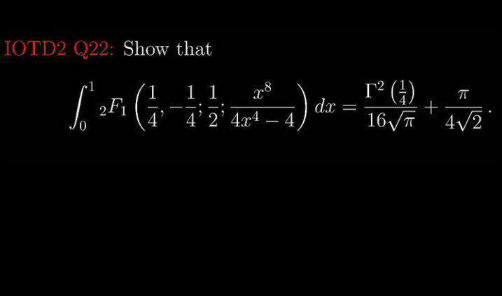
AllQuestion and Answers: Page 504
Question Number 169054 Answers: 2 Comments: 0
$$\int\frac{\mathrm{3}{x}}{\left(\mathrm{1}−\mathrm{4}{x}−{x}^{\mathrm{2}} \right)}\:{dx} \\ $$
Question Number 169053 Answers: 1 Comments: 0
Question Number 169052 Answers: 1 Comments: 3
Question Number 169051 Answers: 1 Comments: 4
Question Number 169050 Answers: 1 Comments: 0
Question Number 169049 Answers: 1 Comments: 0
$$\int{x}^{\mathrm{2}} {e}^{\frac{{x}^{\mathrm{2}} }{\mathrm{2}}} \\ $$$$ \\ $$$${Mastermind} \\ $$
Question Number 169048 Answers: 0 Comments: 0
$${find}\:\int_{\mathrm{0}} ^{\infty} \:\:\frac{{lnx}}{{x}^{\mathrm{2}} −{x}+\mathrm{2}}{dx} \\ $$
Question Number 169044 Answers: 1 Comments: 0
Question Number 169038 Answers: 2 Comments: 1

Question Number 169042 Answers: 0 Comments: 0

Question Number 169013 Answers: 2 Comments: 1

Question Number 169009 Answers: 1 Comments: 10

Question Number 169004 Answers: 1 Comments: 3
Question Number 169000 Answers: 1 Comments: 0

Question Number 168982 Answers: 1 Comments: 1

Question Number 168980 Answers: 0 Comments: 7

Question Number 168979 Answers: 0 Comments: 0
Question Number 168978 Answers: 1 Comments: 0
Question Number 168977 Answers: 0 Comments: 0
Question Number 168952 Answers: 1 Comments: 0

Question Number 168948 Answers: 1 Comments: 0

Question Number 168946 Answers: 2 Comments: 1

Question Number 168942 Answers: 0 Comments: 2

Question Number 168956 Answers: 4 Comments: 0
Question Number 168937 Answers: 1 Comments: 0
Question Number 168968 Answers: 0 Comments: 0

Pg 499 Pg 500 Pg 501 Pg 502 Pg 503 Pg 504 Pg 505 Pg 506 Pg 507 Pg 508
